Blog - Inspiration

Kids' Rooms: Decorating Ideas for Every Age
From a nursery to a place to fill out college applications, a child's room is a personal space that is uniquely theirs. While some pieces can last from the newborn days through the teen years, other items are age-specific. Providing your child with furniture that will adapt to their changing needs will give them a place to recharge, learn and grow. In addition, creating a space that blends timeless pieces with age-appropriate whimsy will result in a space they'll love spending time in. Explore kid’s room ideas, the must-have pieces for every stage and our picks for items that can grow with your child.
Infant Room Decor
Other than a crib, choose pieces that have more longevity. For example, a full-size dresser instead of a changing table will continue to fit into the room’s design as your baby grows up. Simply adding a changing cushion and changing table topper for your changing essentials is all you need to transform the dresser into a changing table.
Also, a stylish daybed, like the Arya Daybed, can be a life-saver during the early days of sleepless nights. It is streamlined to be tucked into a corner and can give you a place to catch some sleep if your baby is waking up frequently.
An oversized ottoman offers a host of benefits to a nursery. An ottoman gives you a place to rest your feet during late-night feedings, and you can also use it to change your baby’s diaper during the early months. Additionally, an ottoman, such as the Liv Ottoman with shoe storage, can serve as extra storage for the abundance of baby blankets you will inevitably accumulate. Finally, when your baby begins walking, they can use it for extra balance and to gain confidence.
And, as sweet as they are, babies can be messy and accumulate many things. So whether you build a custom closet, they can grow into or you have an ample amount of baskets and storage solutions readily accessible, having an organization system is vital for your relaxation.

Toddler Room Decor
In a curious and quickly developing toddler's room, avoid furniture made especially for children, such as a child-size dresser, toddler bed or changing table. Purchasing child-size furniture puts an expiration date on the pieces, and you will need to re-design the room several years later. Instead, investing in high-quality furniture and a full or queen size bed will give your child foundational pieces they can grow into. An exception is a child-size table and chairs, so they have a place to create their masterpieces. Toddlers learn through play, so they need a spot for creativity and imagination. Whether it is a tent, canopy or tiny house, a space that is theirs will give them ownership and a place to flourish.
Creating a functional space for adults will make your time in your child’s room more enjoyable. Whether it’s a cozy chair to cuddle up and read books, or a window seat with plenty of cushions, having a place to relax, read and cuddle with your child is one of the essential elements of the bedroom.
Pre-Teen Room Decor
When your child is exploring their interests and individuality, it’s important to incorporate elements in their room that express their interests. For a pre-teen’s room, taking an approach of selecting timeless pieces but accessorizing with their interests creates a space that will last long but will reflect their individuality.
Involving your child in the design process is essential, so they feel ownership in the space. Take this feedback into consideration — then edit down. For example, if your child wants an all-pink room, lean into it. However, instead of saturating all the walls in pink, opt for neutral wall colour and paint the trim and doors pink for a more understated look.
Your pre-teen will also need a place to do homework, and having a dedicated area in their bedroom will make it uniquely theirs. Investing in a high-quality desk and comfortable chair that will last them through their teen years.

Teen Room Decor
Between homework, sports, social events, work and college applications, your teen could probably welcome some downtime in their schedule. However, sleep is so vital to the formative teen years, so consider upgrading the mattress to a more appropriate version for an adult.
Also, with their desk system in place from the pre-teen years, assess any upgrades that are needed. This may include upgrading the chair to an ergonomic chair, adding a charging station or a whiteboard to help with homework or remote learning.
Designing a children’s bedroom where a child can still be a child but also stands the test of time is the key to ensuring a room will transition throughout their life stages. Investing in the right pieces and taking your child’s interests to heart will result in an age-appropriate space.
- Dana Mitchell

Tips for Selecting a TV Wall Unit
Maximize your space by investing in the right entertainment centre. A TV wall unit can elegantly display your television while providing ample storage, without cluttering up the room with too many cabinets and consoles.TV wall units come in various shapes, sizes, colours and materials that can meet a wide range of different TV and living room furniture needs. Whether you’re designing a home theatre or a family gathering space, read on for tips on selecting the most suitable TV wall unit for your area.
Assess the Size and Layout
Measuring your television and space planning is key to selecting the best TV wall unit for your room. Considering your room's layout and how the TV will be installed is your first priority before selecting colours and finishes. If the TV wall unit is too small, the space will look awkward and unfinished, but if it is too large, the room will feel cramped. Don't forget about the rest of the furniture, and make sure you leave enough room for everything to create a polished, cohesive layout.
Just as important is to ensure your television is scaled correctly to the wall unit. If you plan on placing the TV on a stand, make sure your stand is larger than the TV – usually a few inches on either end looks best.
Similarly, if you plan to hang the TV on the wall, the TV wall unit should have a large enough opening to accommodate this.
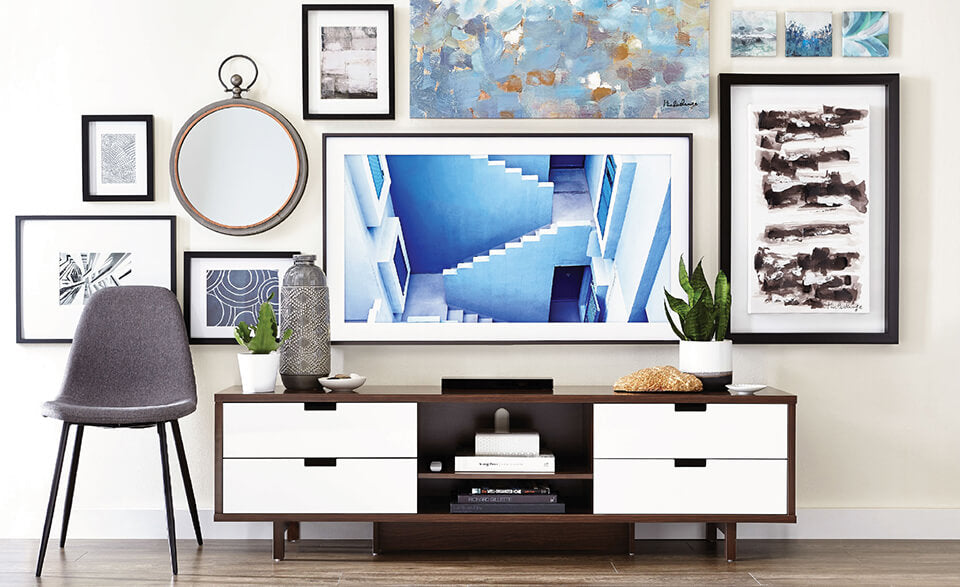
Complement Your Design Aesthetic
The TV wall unit’s design style and colour should complement your home’s existing decor. If you have a contemporary home, you can enhance the room with a sleek and minimalist TV stand. Likewise, if your decor aesthetic is traditional, a TV stand with classic lines will align the best with your room’s overall style. The colour, shape and texture of the TV wall unit should all be part of your design assessment.
Ensure Adequate Storage
When assessing TV unit options, be sure to check that the unit has enough storage for your particular needs. You need enough storage space to fit your cable box, cords, game consoles and any other electronic gadgets. Additionally, you will likely want enough surface space to display decorative accents like picture frames, books or fresh flowers.
Match Your Lifestyle
A TV wall unit should integrate with your lifestyle in addition to matching the design style. If you have young children, solid cabinet doors would allow you to conveniently store toys and gadgets when they are not playing with them. Or, if you enjoy creating displays with your belongings and accessories, then glass doors and open shelving would allow you to explore your design creativity.
Different TV Wall Unit Options
There are many different styles of TV wall units. Whether you prefer farmhouse, contemporary or traditional, below is a round-up of different wall units to match every style preference.
- Taditional: White TV stand with a dark brown tabletop, like the Emry Entertainment Centre, brings character and classic style to a living area. The entertainment centre’s roomy cabinets offer plenty of space for entertainment essentials while deep drawers provide storage space for those inevitable odds and ends.
- Contemporary: A TV wall unit in a sleek, streamlined design, such as the Antoni 3-Piece Entertainment Centre, brings a contemporary look to any living area. The white entertainment centre comes complete with a firebox, which adds a warm touch and visual interest to a room. The realistic flame effects will set the mood for romantic nights in, and a no-heat mode will let you enjoy it even on warm summer nights. The multiple shelves and drawers ensure there’s ample space for electronics and decor.
- Rustic: A rustic yet refined TV wall unit, like the Sydney Barn-Door 6-Piece Entertainment Centre, brings a casual farmhouse vibe to your living space. This trendy entertainment centre features sliding barn doors, contrasting hardware and creates the perfect focal point for your modern farmhouse living room.
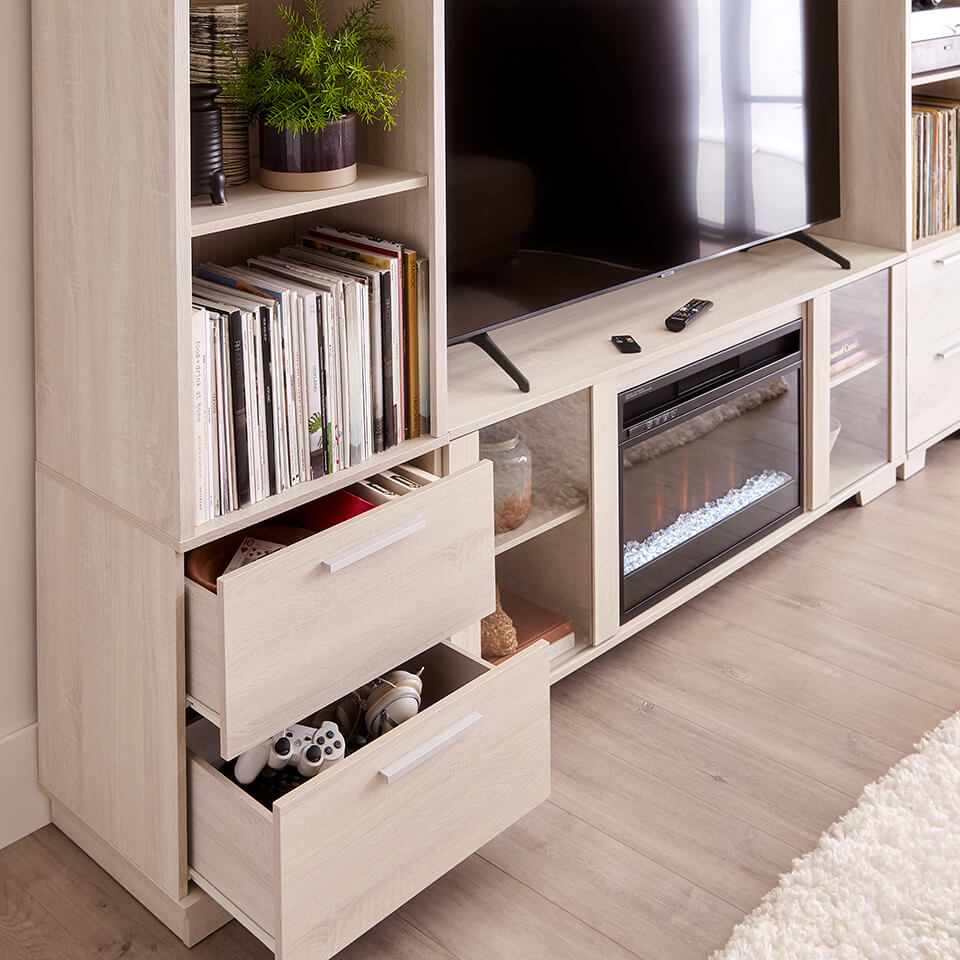
Wall units are an efficient way to conceal your belongings while displaying your TV elegantly. A strategically selected TV wall unit can make your room appear larger, more organized and is a beauty to behold.
- Dana Mitchell

The Different Kinds of Fireplaces for the Holidays
A fireplace is a place to gather with family and friends and is often associated with nostalgia and cozy winter memories. It’s typically the focal point of a room and can set the tone for the room’s overall design. However, not all homes have a fireplace. If you’re looking to add the ambiance of a fireplace while saving space, there are alternative options available that provide the benefits of a traditional fireplace. Consider the following fireplace options to create a stunning focal point in your home and to have a warm winter ahead.
Benefits of an electric fireplace
If your home doesn’t have a working fireplace, an electric fireplace is an excellent alternative. It offers the warmth and coziness of a traditional fireplace but is also a space saver, comes in various sizes, requires less maintenance and is a safer alternative.
An electric fireplace plugs into the wall and uses lights to create the appearance of flames. This means there are no actual flames or fumes, so you get the look of a fire without the smoke. Since the flames aren’t real, an electric fireplace also has significantly less maintenance. You don’t need to clean the ash, soot or chimney like you would in a real fireplace.
As your energy bills increase over the cold winter months, an electric fireplace can help keep these costs down. With the added warmth from the electric fireplace, you can save on your heating costs. Electric fireplaces are also known for their longevity. They typically last for years and show minor signs of wear and tear.
If you have young children or pets, an indoor fire can be a concern. However, an electric fireplace doesn’t come with the safety risks associated with traditional fireplaces because they don’t give off fumes, are not hot to the touch and some models have automatic shut-off functionality. You can even run many models in a "no-heat" mode – a perfect way to enjoy the style of your fireplace, even during the heat of summer.

Lastly, design options for electric fireplaces are extensive and there is an electric fireplace style to fit every aesthetic. With models that include a mantle, you can even hang your favourite holiday decor!
For a glam look, the Flint Glam Fireplace is coated from top to bottom in sparkle, thanks to silver glass mirrors and diamond-like accents. The small shelf on top can hold a 42-inch television or display your family photos. And, you can control the glow of the fire with a remote control.
The epitome of a Christmas fireplace, the Austen All-In-One Fireplace will add some classic warmth to your living room. Framed by a natural Burwell flagstone wall mantel and complemented by cappuccino wood, the grey-arched fireplace presents a stately style. It’s familiar and classic in design, but with a modern electric insert so you can safely watch the flames dance around and illuminate the room.
Benefits of a firebox
A firebox offers similar benefits as an electric fireplace, but is always housed in a larger piece of furniture.
For a sleek and refined look, the Kiara TV Stand with Crystal Ember and Log Firebox brings an elegant look to your home entertainment space. While this piece is equipped with shelving options to store your electronics and other items, you can also snuggle up in front of the fireplace with a flame setting you can operate with or without heat, so the mood is just right all year round.
If farmhouse style is more your taste, the Monte TV Stand with Firebox has a white finish, rustic walnut top and iron barn door rail to bring a cozy farmhouse feel to your living space. With both cubbies and cabinets, there is plenty of storage space available. Then, when it’s time to relax during the evening, you can safely watch the dazzling flames dance around in the electric firebox.
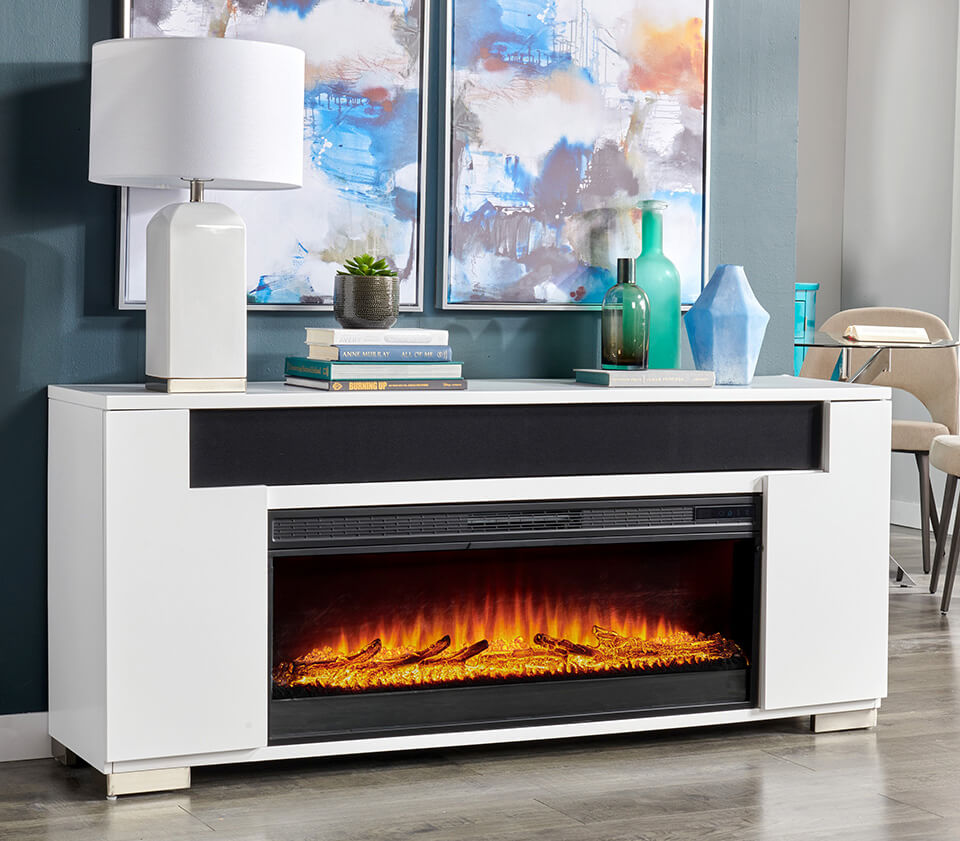
As the temperatures drop, it’s the perfect time to think about creating a fireplace focal point that will make you look forward to the cooler evenings ahead. The right fireplace for firebox will serve as a warm, cozy backdrop for the big and small celebrations that lie ahead. They can even be mounted on the wall for a streamlined, modern look.
- Dana Mitchell

What You Need to Know About Bed Frames
Since buying a new bed frame isn’t a frequent activity, purchasing one may feel overwhelming. Besides showcasing your unique style, a bed frame is necessary because it supports the box spring and keeps it secure. Placing a boxspring directly on the floor will scratch the floors and risk the mattress sliding off. A bed frame is also the main design element in the room and often is also the focal point. Read on to learn more about what to look for in a bed frame, when you need a boxspring, choosing a bed frame, and how you can style a bed frame.
What to Look for In a Bed Frame
Before selecting a bed frame’s design, you need to understand your functional requirements to ensure you choose the structure that will give you the best night’s sleep. Below are common factors to consider when you’re bed frame shopping.
- Mattress size: If you already have a mattress, the bed frame needs to match the size of your mattress (i.e. if you have a king-size mattress, you will need a king-size bed frame).
- Bedroom size: If you are buying an entirely new bed and are debating on sizes, factor in that you need three feet of clearance around the sides and foot of the bed so you can comfortably move around the room.
- Bed frame height: If you prefer to be lower to the ground, a platform bed or a low-profile bed frame may be the best choice for you. If you want more visual height or have mobility issues, a taller bed frame may be best for you.
- Bed frame material: Bed frames typically are made of wood and metal. High quality wood and high quality metal are comparable in construction, so the choice ultimately comes down to appearance.
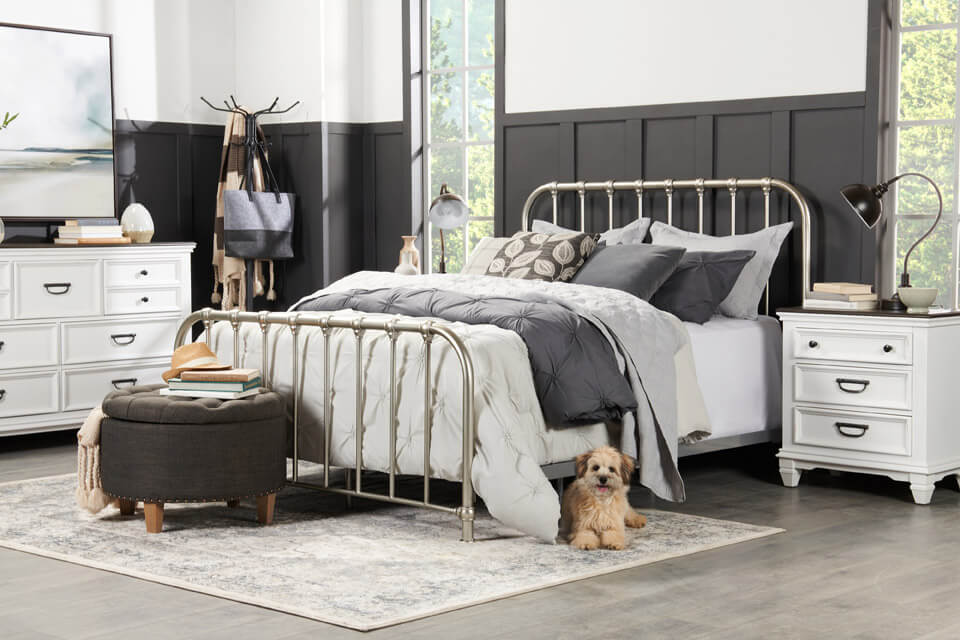
When Do You Need a Boxspring?
A boxspring is necessary if you have a wood or metal bed frame. Most bed frames aren’t strong enough to support a mattress, so a boxspring is needed for extra support and weight distribution. If you have a platform bed, you don’t need a boxspring.
Choosing a Bed Frame
There are many different bed frame designs from which to choose. As long as the frame can securely support your mattress, choosing a bed frame typically comes down to the style you want. Below breaks down the different types of standard bed frames.
- Traditional bed frame: A standard bed frame consists of a head, foot and sides to secure the mattress on all four sides, such as the Passages Queen Bed . It is typically rectangular and can be upholstered, wood or metal.
- Platform bed frame: A platform bed frame offers mattress support, has a modern design and eliminates the need for a boxspring. The Mila Queen Platform Bed is a great pick when looking for a platform bed.
- Storage bed frame: Like a platform bed, a storage bed frame doesn’t require a boxspring. A storage bed frame has drawers and compartments at the base and can reduce the number of additional furniture pieces you may need. A storage bed, like the Abby Queen Side Storage Bed, is helpful in a smaller room.
- Adjustable bed frame: An adjustable bed frame is multi-hinged and can help you comfortably sit up in bed, let you lounge in a different position than your partner, and remember your preferred sleep position. You will also need a mattress that is compatible with an adjustable bed frame.

How To Style a Room with a New Bed Frame
To complete your room’s new look, accessorizing your new bed with varying materials and textures will make your space feel complete. A crisp set of sheets, a plush comforter and an array of pillows in a calming color palette will invite you in and entice you to stay.
A thoughtfully selected bed frame will add both function and style to the bedroom and make your bedroom feel uniquely you. Whether it's a traditional bed frame, a platform bed, or an adjustable bed frame, a bed frame is the key to a good night’s rest and a beautiful bedroom.
- Dana Mitchell

Creative Ways to Divide Your Open Concept Room
An open concept home creates a spacious and airy feel and is ideal for entertaining and families with young children. The openness also maximizes the square footage of livable space. However, creating distinct areas within an open floor plan can feel challenging because of the lack of walls and hallways. Read on to learn creative room divider ideas to separate your open concept room so you can maximize every square inch of functional living space.
Separate Seating Spaces
In an open concept home, the floor plan is the first step to creating distinct spaces. One of the easiest ways to divide a room is the way you position your furniture. For every separate area, arrange the furniture towards each other, so each zone has a conversation area. This configuration also means the back of the furniture will face the different zones, creating a visual ending of one space and beginning of the next.
Below is a suggested furniture combination to create a distinct seating space in a living room, separate from the other areas of the open concept.
- An elegant, linen-coloured sectional: A neutral sectional, like the Jairo 3-Piece Linen-Look Fabric Sectional, provides ample seating and is a foundational piece that creates sual lines to define a living area.
- A navy accent chair: An accent chair in a bold, yet neutral color, such as the Sylvie Linen-Look Fabric Modular Chair, serves as both a statement piece, as well as a functional seat.

- Coffee table: Every seat in the sitting area should have immediate access to a flat surface to rest a beverage, book or snack. Nesting coffee table in the center of the furniture layout, similar to the Veranasi Nesting Coffee Tables, provides the benefit of a singular coffee table, with the option of separating the two tables to provide extra surface space.
Rug Rules
Rugs are an excellent way to define particular areas in an open floor plan. To create distinct zones, every space should have its own rug. This more or less draws a line around that particular area. A fool-proof equation is as follows:
- Entryway: Lay down a runner that goes from the front door down the hallway.
- Dining area: Place an area rug that goes under the dining table and chairs. The rug should extend beyond the chairs when you pull them out from the table.
- Living area: Use an area rug under the sofa, accent seating and coffee table. The rug should anchor the furniture. The front legs — if not all of the legs — of the sofa and chairs should be on the rug.

Selecting neutral rugs will provide visual continuity and allow you to layer different, coordinating colors within each space. An off-white linen rug, like the Ankara Linen Area Rug, will coordinate with nearly every style and color.
Create Space with Console Tables
Console tables can serve as a room divider and visually break up different living spaces within an open concept space. Placing a console table behind a sofa, for example, creates a partition to mark where the living area ends and the dining area begins. Styling the console table with lamps, frames and decorative accents adds additional height, creating more separation.
A neutral console table, like the Kimberly Hall Table doubles as a functional storage solution as well, which is necessary in an open floor plan.
Bring In Bookcases
A bookcase has a similar effect on an open floor plan room as a console table, but it offers more privacy because of its height. Several bookcases side by side can create the impact of a wall due to the height they offer. When you’re shopping for bookcases, make sure that they are either open shelving or finished on the back.
A bookcase that is open on top and has storage on the bottom, like the Taryn Office Credenza, is ideal for an open concept space. The open top creates a seamless divide between areas, and the sliding doors on the lower quadrant provides hidden storage space.

Open concept floor plans are a great way to make your home feel more extensive and expansive, but creating distinct zones can make the space more functional and visually warmer. Now that you know how to divide a room, a few strategic furniture adjustments, coupled with adding some new pieces, will create an open concept that is both airy and cozy at the same time.
- Dana Mitchell

The Types of Ceiling Lighting and How to Best Integrate Them Into your Home
Lighting is an essential design element. It serves a highly functional role and can also transform the aesthetic of a space. There are many different types of lighting to choose from — all lending a unique and different look. Pendant lighting — a light fixture that hangs from the ceiling via a chain, rod or cord — can be the room's statement piece if selected strategically. Pendant lighting is typically hung over a kitchen island, dining table, entry hall or centre of a room. Read on to learn more about the various pendant light styles and how to incorporate lighting design throughout your space.
Types of Pendant Lights
When you’re considering pendant lighting solutions, the styles and options can feel endless. Because of various types, sizes and shapes, pendant lighting can be incredibly versatile. Additionally, pendant lighting saves space since these pieces hang from the ceiling and don’t take up surface and floor space. Whether you’re looking to create a coastal, glam, mid-century modern or transitional space, there is a pendant light design for you. The following are the most common types of pendant lights.

Drum Pendant Light
A drum pendant light resembles the shape of the classic percussion instrument and is available in different sizes and colours, depending on your design. Drum pendants, like the Arkas Pendant Ceiling Light, often come in a white linen fabric which gives off a soft glow, while adarker shade creates a more dramatic effect by blocking some of the light shining through.
Where to use drum pendant lighting:
- Use two or three in a row to illuminate the kitchen island
- Hang a statement piece above your dining table
- Illuminate a reading nook in a family room or living room
Globe Pendant Light
This type of pendant light has a round shape and is typically a mid-century modern style. Globe pendant lights are usually made of clear glass and have a sleek look that eliminates visual clutter. This transparency results in a bright glow. As demonstrated by the Pavo Minor and Major Pendant Ceiling Lights, globe pendants look great independently or together to achieve a stunning statement.
Where to use globe lighting:
- Hang above a powder room sink
- Illuminate a long hallway
- Install two or three over a kitchen island
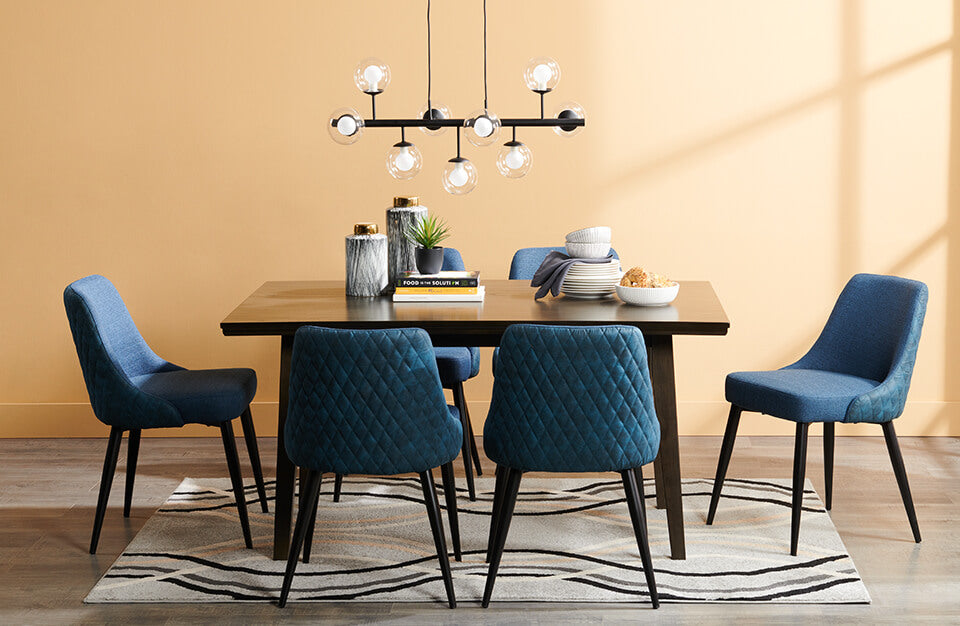
Bowl Pendant light
Classic and functional, a bowl pendant light may be the most commonly used pendant light. The bowl may face upwards or downwards, which impacts the direction the light is cast. For example, a bowl that faces upwards provides ambient light, while a bowl that is directed down –such as the Pegasus Minor and Major Pendant Ceiling Lights – provide task lighting.
Where to use bowl lighting:
- Hang above a workspace for task lighting
- Create ambient lighting in a dining room, with a dining table as an anchor
- Install above an armchair in your living room
Exposed Bulb Pendant Light
If you’re looking for an industrial or rustic type of lighting, an exposed bulb pendant light (also known as an Edison light) like the Ursa Major Pendant Ceiling Light is a minimal design. An exposed bulb pendant is simply a light fixture and bulb — no shade required.
Where to use exposed bulb lighting:
- Create task lighting over a kitchen sink
- Illuminate an entryway
- Stagger above a dining table
Mini Pendant Light
A mini pendant light is a scaled-down version of a standard pendant light and works best in smaller spaces. You can group multiple mini pendant lights, like the Sirius Pendant Ceiling Light, to create a visual statement and create a more significant light source. When grouping mini pendant lights, select an odd number of lights to make the most visually appealing design.
Where to use mini pendant lighting:
- To create task lighting in a smaller space, like a laundry room
- Hang in a closet
- Group multiple lights over a dining table or workstation
Cage Pendant Light
A cage pendant light, also known as a lantern light, has a framed silhouette, usually in the shape of a lantern. Sometimes there are glass panes in the lantern, but the frames can also be open. Depending on the style, there can be a single light bulb in the cage, like the Arion Pendant Ceiling Light, or a multi-light candelabra, like the Brahe Pendant Ceiling Light.
Where to use cage pendant lighting:
- Hang in the foyer as a statement piece
- Use as a focal point in the dining room
- Use two oversized pendant lights over a kitchen island
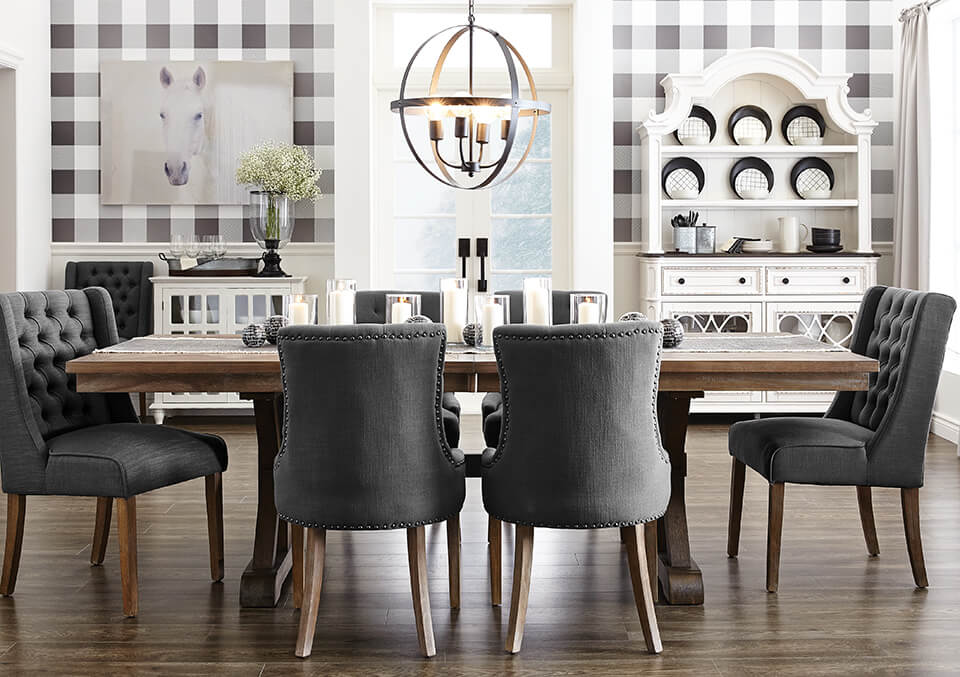
Chandelier Lighting
Chandeliers may make you think of luxury and extravagance; however, the wide variety of styles and sizes can work in any space (the Dalia Ceiling Light is a more modern take on the classic chandelier). Although chandeliers can make a statement in an entryway or hallway, they can also make even the most casual dining area feel extra special or add an element of grandeur to a primary bedroom.
When you’re creating a lighting design plan for your home, understanding the different types of pendant lighting can help. Whether you’re looking to highlight your kitchen island, create task lighting above your workspace or have ambient lighting to relax in the living room, pendant lighting can provide the visual impact your space needs.
- Dana Mitchell



